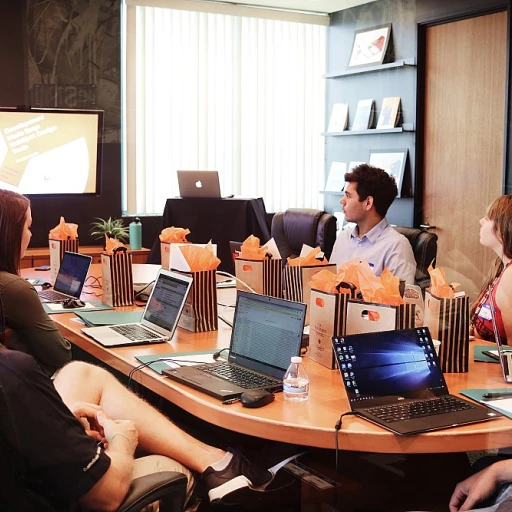Understanding the Importance of 1-on-1 Meetings in Remote Work
The Role of Regular Check-ins
In the evolving landscape of remote work, one-on-one meetings with your manager have become increasingly pivotal. These meetings serve as structured platforms where managers can address individual team members directly, fostering a sense of connection and understanding that might otherwise be absent in a virtual environment. Regular check-ins are more than mere formalities; they are opportunities to ensure that employees are aligned with the company’s goals and developing at a satisfactory pace.
Communication as a Key Component
Effective communication lies at the heart of productive one-on-one meetings. A well-planned meeting agenda can help managers and employees identify key discussion points, address ongoing challenges, and recognize achievements as they come. It's crucial to maintain an open and supportive atmosphere where team members feel comfortable to discuss their concerns or provide candid feedback. Open dialogue encourages innovation, creativity, and strengthens work relationships.
Importance of Personalization
Each team member is unique and comes with different needs and challenges. As such, meetings should be tailored to the individual's role, responsibilities, and current work projects. Utilizing customized meeting templates can help in organizing the content of the meetings, ensuring that time is used wisely and that both parties come away with clear action items. Personalized check-ins increase employee engagement and motivation, making them a valuable tool for any remote manager.
Setting Clear Objectives
These meetings should not only focus on ongoing tasks but also include discussions around long-term goals and personal development. Having a clear set of objectives helps track progress over time and establishes accountability. Managers and their direct reports can work jointly to identify goals and the necessary steps to achieve them, creating a roadmap for success within the organization.
Explore various creative greetings to start your meetings on a positive note. A welcoming and energetic opening can set the tone for effective communication throughout the meeting.
Preparing for Your 1-on-1 Meeting
Preparing for a Productive Meeting
Effective preparation is key for any successful one-on-one meeting, especially in a remote setting where challenges like communication gaps can arise. Making the most of these meetings requires organization and clarity. Here are some key steps to follow:- Set a Clear Agenda: Define the meeting agenda ahead of time so both you and your manager know what to expect. Include specific topics, questions, or issues you wish to discuss. This helps in keeping the meeting focused and productive.
- Collect Your Thoughts: Reflect on your recent work and identify any achievements, challenges, or questions you might have. Preparing these points ensures a comprehensive discussion and enables your direct report to provide relevant feedback and support.
- Use Meeting Templates: Utilize a template to streamline your preparation process. Templates help organize your thoughts and ensure all important topics will be covered during the meeting.
- Identify Action Items: Think about potential action items that can come out of the meeting. This could be specific goals you want to achieve or initiatives you might need support with.
- Schedule Regular Check-ins: Ensure you have set times for these one-on-one meetings. Regular check-ins help maintain momentum and accountability for both parties.
Creating a 1-on-1 Meeting Template
Developing a Robust Framework for Your 1-on-1 Meetings
Crafting a structured framework for your 1-on-1 meetings is crucial. A well-organized meeting template can save time and ensure that all essential topics are covered, enabling you to have a productive conversation with your manager. Creating or choosing a template that fits your and your manager's style can streamline this process.- Meeting Template Components
- Agenda: Outline the key topics you plan to discuss. This can include progress on goals, feedback, and any action items from previous meetings. Establishing a clear agenda helps keep the meeting focus and ensures important points aren't overlooked.
- Meeting Questions: Prepare a set of open-ended questions beforehand. These could be about your work challenges, career growth, or team dynamics. Such questions encourage open dialogue and offer a chance for honest feedback.
- Check-ins: Regularly scheduled check-ins help maintain alignment and foster a sense of connection with your manager. Including time for personal updates can also be beneficial for building rapport.
- Choosing the Right Tools
- Google Docs: Use Google Docs to share and collaborate on the meeting agenda. This allows both you and your manager to edit the document, keeping everyone in the loop.
- Templates: Opt for ready-made templates that suit your meeting style or customize one based on your needs. Sites offering templates for download or examples to view can be a starting point.
- Align with Team Goals
- Direct your meeting towards aligning your individual goals with wider team objectives. Discuss any support you need from your manager or team members to achieve these goals. This alignment ensures your work contributes effectively to overall team success.
Effective Communication Strategies
Strategies for Successful Dialogue
Effective communication remains the bedrock of productive 1-on-1 meetings, particularly in a remote work setting where misunderstandings can easily arise. Crafting an open dialogue approach requires intentional consideration of both content and format. Here are some strategies to ensure impactful communication during these sessions:
- Set a Clear Agenda: Begin with a well-structured meeting agenda to create a focused conversation. This helps both you and your manager delve into specific topics and achieve meeting goals efficiently. A template one with specific agenda items can be downloaded from various online resources.
- Foster Open-ended Questions: Encouraging questions that prompt deeper discussion allows employees to share insights and concerns more openly. This ensures both parties fully understand each other's perspectives and work collaboratively to find solutions.
- Facilitate Regular Check-ins: Consistent check-ins aid in building trust and provide direct reports with a platform to voice their thoughts and feedback. Setting specific times for these check-ins can enhance clarity and preparation.
- Encourage Transparent Feedback: Establishing an environment where honest feedback is appreciated encourages continuous improvement. Constructive criticism should be welcomed and addressed promptly to help refine working relationships.
- Employ Active Listening: Managers play a crucial role in effective communication by practicing active listening techniques. Understanding employees' concerns and suggestions leads to meaningful action items and bolsters team morale.
- Utilize Technological Aids: Make use of video conferencing tools and online meeting templates to bridge the communication gap. Tools like Google Docs for real-time collaboration can enhance clarity and ensure all topics are properly covered.
Through these strategies, 1-on-1 meetings become a pivotal touchpoint for strengthening the synergy between managers and employees. By fostering open communication and ensuring each meeting is well-structured, team members feel more engaged and valued in their roles.
Addressing Challenges in Remote 1-on-1 Meetings
Overcoming Common Remote Meeting Challenges
When conducting 1-on-1 meetings remotely, unique challenges often arise due to the absence of face-to-face interaction. Here are several strategies to address these challenges effectively:- Technical Difficulties: Ensure both you and your manager are equipped with reliable technology. As part of your meeting preparation, double-check that all necessary applications, such as video conferencing tools and meeting templates in Google Docs, are up and running.
- Time Zone Differences: Scheduling can be tricky with team members spread across different time zones. Use shared calendars to find a mutually agreeable time and include check ins in your meeting agenda. Flexibility shows your commitment to building rapport.
- Lack of Non-verbal Cues: Be mindful of the absence of body language and facial expressions. Encourage open questions and feedback to foster clarity and understanding. Regularly check in with your direct report to ensure that both parties are on the same page.
- Maintaining Engagement: Stay focused and engaged by using clear meeting agendas. Discuss action items and goals thoroughly to keep the conversation productive. Organizing the talking points in advance can help direct the meeting effectively.
- Employee Concerns: Remote work can sometimes exacerbate feelings of isolation or concern among employees. Approach these meetings with an empathetic mindset and offer support, addressing any issues that may affect their work or well-being.
Evaluating the Success of Your Meetings
Measuring the Effectiveness of Your One-on-One Meetings
Determining whether your one-on-one meetings are achieving their purpose can be as vital as the meetings themselves. To evaluate the success of your meetings, consider focusing on a few essential elements.
- Feedback and Action Items: After each meeting, take note of the feedback provided and any action items outlined. Regularly check in with employees to ensure follow-up on these items. This not only solidifies accountability but also helps in tracking progress.
- Employee Engagement: Gauge how open and engaged your team members are during discussions. Are the meeting questions promoting constructive dialogue? An increase in open communication and voluntary feedback can be a sign of trust and effective communication strategies being deployed.
- Meeting Goals: Reflect on whether the goals set during the meeting are being accomplished. Use a meeting agenda or template to help keep track of these goals. Have your direct reports found the meeting templates helpful in structuring subsequent meetings?
- Efficiency of Time: Assess whether the meetings are a productive use of time. Are they scheduled too frequently, not allowing enough time for action items to be completed? Or are they spaced too far apart, hindering timely check-ins?
- Adaptability and Improvement: Be prepared to adapt your meeting style based on the feedback and outcomes you observe. Would a new meeting template be more effective and should you consider reviewing other templates available online to find the best fit for your team?
Regular evaluations, paired with honest feedback, can significantly enhance not only your time management but also the overall productivity and satisfaction levels of your direct reports. Remember, the purpose of these meetings is to facilitate a better working relationship with employees, foster growth, and contribute to the overall success of your team.










